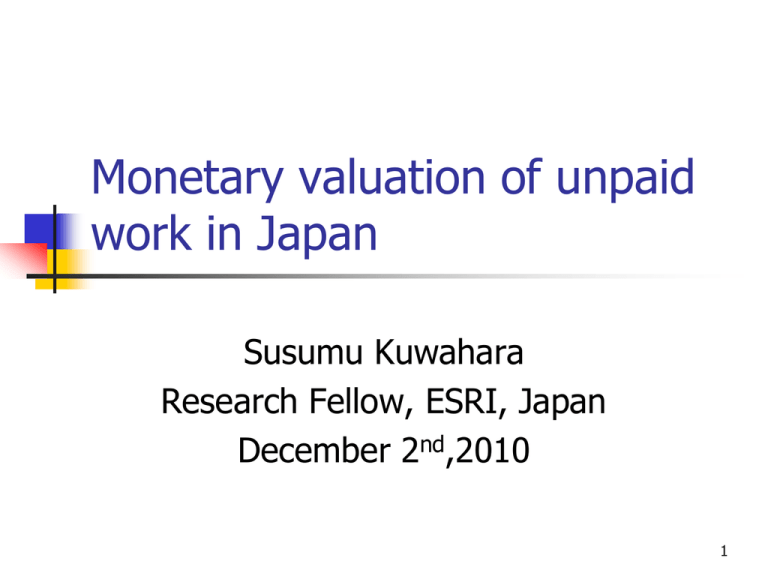Monetary valuation of unpaid work in Japan Susumu Kuwahara Research Fellow, ESRI, Japan
advertisement

Monetary valuation of unpaid work in Japan Susumu Kuwahara Research Fellow, ESRI, Japan December 2nd,2010 1 Background In Japan, strong gender bias in housework, child care and elderly care/nursing has been regarded as a serious problem. The need to measure the economic value of these activities and their burden on women in a form that allows comparison with other economic indicators is particularly strong. 2 Beijing Declaration and Platform for Action, The Fourth World Conference on Women Chapter 4 Strategic objectives and actions Paragraph 68 (b) Devise suitable statistical means to recognize and make visible the full extent of the work of women and all their contributions to the national economy, including their contribution in the unremunerated and domestic sectors, and examine the relationship of women’s unremunerated work to the incidence of and their vulnerability to poverty. 3 History 1995 The Fourth World Conference on Women. 1997 The first report of the monetary valuation of unpaid work in Japan, estimates on 1981, 1986, 1991. 1998 The second report, estimates on 1996. 2009 The third report, estimates on 2001, 2006. 4 From the point of “Measuring progress” Measurement of Economic Welfare (MEW) by Tobin, Nordhaus(1973) includes unpaid work. Net National Welfare (NNW,1978), Japanese version of MEW, includes unpaid work, too. The Index of Sustainable Economic Welfare (ISEW), the Genuine Progress Indicator (GPI) also maintain unpaid work as their components. 5 1. Time Use Survey 6 Input Method As the valuation method, we use only the input method. The formula for assessment is; Value of unpaid work = per capita hours of unpaid work * hourly wage *population As a result, our assessment heavily relies on the time use survey. 7 STULA The "Survey on Time Use and Leisure Activities (STULA)" is conducted by the Statistics Bureau of the Ministry of Internal Affairs and Communications. The STULA aims to obtain comprehensive data on daily patterns of time allocation and leisure activities. The STULA was first administered in 1976, and has been carried out every five years since then. 8 The STULA covers those items Time use on a single day Participation in leisure activities during the past year Frequency of participation in leisure activities during the past year The survey also contains a questionnaire on attributes of individuals and households. 9 Two types of questionnaires since 2001 Questionnaire A adopts a pre-coding system (i.e. multiple choice style) . Used for around 76,000 households. Questionnaire B uses diary method or after-coding system, which is more comparable to Harmonized European Time Use Surveys, HETUS, used for around 4,000 households. 10 2. Scope and method of monetary valuation of unpaid work 11 Scope of unpaid work "Unpaid work" defined here covers only unpaid work in which the service provider and the service beneficiary are separable (i.e., the service can be provided by a third party) and the service can be provided in the market. Namely, the "third party criteria" is applied. 12 Type of unpaid work Housework (cooking, cleaning, laundry, sewing and knitting, miscellaneous family affairs) Elderly/nursing care Child care Shopping Volunteer and social activities 13 The method of monetary valuation As for time use, we have only STULA. However, as for wages to be applied to each unpaid work, there are various options. Opportunity-cost-method (OC) Replacement-cost-method Specialist approach (RC-S) Generalist approach (RC-G) 14 Opportunity costs Oppotunity costs 3,000 2,500 yen 2,000 Women, 2001 Men, 2001 Women, 2006 Men, 2006 1,500 1,000 500 0 15- 20- 25- 30- 35- 40- 45- 50- 55- 60- 6519 24 29 34 39 44 49 54 59 64 age 15 Replacement-costs, Specialists Hourly wages, unit: yen Corresponding occupations 2001 2006 Cooking average of chef and apprentice chef 1,247 1,167 Cleaning Building cleaning 998 976 Laundry Laundry man 1,133 1,026 Sewing and knitting Sewing machine operator 879 887 Miscellaneous family affairs Janitor 1,341 1,198 Elderly/nursing care Average of nurse assistance and home helper 1,139 1,139 Child care Child care workers 1,278 1,235 Shopping Janitor 1,341 1,198 Volunteer work Weighted average of medical, social security, social welfare and education 1,872 1,823 H O U S E W O R K 16 Replacement-costs, Generalists Unit: yen Year Hourly wage 1996 880 2001 965 2006 973 17 3. Valuation results using precoding system’s data 18 Assessment using Pre-coding system data set Monetary value of unpaid work/Nominal GDP 30 percent of GDP 25 20 OC RC-S RC-G 15 10 5 0 1981 1986 1991 1996 2001 2006 Year 19 Men’s share is extremely low Unit: billion yen OC Women RC-S Men Women RC-G Men Women Men 1981 48,182 5,082 48,906 3,505 34,945 2,395 1986 63,678 8,150 62,304 5,446 45,192 3,844 1991 84,330 14,528 80,858 10,125 59,684 7,044 1996 98,104 18,011 92,349 13,384 67,396 8,673 2001 106,111 22,704 94,964 15,812 75,343 11,603 2006 106,120 25,749 89,997 17,486 76,805 13,824 (component ratio) 1981 90.5 9.5 93.3 6.7 93.6 6.4 1986 88.7 11.3 92.0 8.0 92.2 7.8 1991 85.3 14.7 88.9 11.1 89.4 10.6 1996 84.5 15.5 87.3 12.7 88.6 11.4 2001 82.4 17.6 85.7 14.3 86.7 13.3 2006 80.5 19.5 83.7 16.3 84.7 15.3 20 Married women’s unpaid work is close to paid work (OC method) Ratio of unpaid work, paid work =100,by age Women 120 100 80 married unmarried separetd/divorced 60 40 20 85- 80~84 75~79 70~74 65~69 60~64 55~59 50~54 45~49 40~44 35~39 30~34 25~29 20~24 15~19 0 21 For men, as long as they earn, unpaid works continue to be minor (OC method) Ratio of unpaid work, paid work =100, by age Men 120 100 80 married unmarried separetd/divorced 60 40 20 85- 80~84 75~79 70~74 65~69 60~64 55~59 50~54 45~49 40~44 35~39 30~34 25~29 20~24 15~19 0 22 4. Valuation results using aftercoding system’s (diary methods) data 23 After-coding system shows larger share of unpaid work 2006 figure, unit: billion yen PrePercent AfterPercent coding of GDP coding of GDP OC method 131.9 26.0 176.1 34.7 RC-S method 107.5 21.2 140.5 27.7 RC-G method 90.6 17.9 118.1 23.3 24 International Comparison Country Japan Korea USA New Zealand Germany Finland * women only Year 2006 2004 2004 1999 2001 2001 percent of GDP 17.9-34.7 13.7-22.5* 18-58 39.0 43.4 36.1 25 5. Comments and conclusion 26 What happened? Gender researchers criticized our methodology. They insist that the wages used for women’s unpaid work might be too small compared with wages used for men, because the wage gap itself is the result of gender discriminations and using these data rather confirms problems than improves situations. 27 However, we think… Despite several shortcomings in the valuation methods, the three reports of the monetary valuation of unpaid work were successful in galvanizing discussions among people on how to evaluate women’s role in the society and economy through unpaid work in Japan. 28 We will go ahead. The Council for Gender Equality recommended that the research should be conducted on the measurement of the unpaid work, such as housework, child care, elderly care, nursing, and volunteer activities, as well as economic and social assessments of the child care and elderly care/nursing. 29 End Thank you for listening patiently 30


